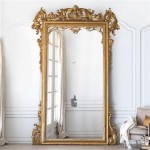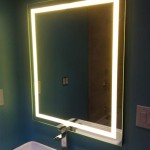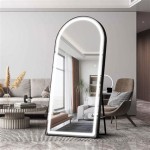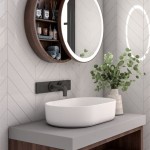How To Hang a Full-Length Mirror
A full-length mirror is a versatile and functional addition to any home. It serves practical purposes like checking outfits and offers aesthetic benefits by creating the illusion of more space and light. Properly hanging a heavy and potentially fragile item like a full-length mirror requires careful planning and execution. This guide outlines the process for securely and effectively hanging a full-length mirror on your wall.
1. Choose the Right Location
Selecting the ideal location for your mirror involves considering both practical and aesthetic aspects. Ensure the chosen wall has sufficient space to accommodate the mirror's full dimensions without obstructing walkways or other furniture. Additionally, consider the natural light sources in the room. Placing a mirror opposite a window can maximize light reflection and brighten the space.
Assess the wall's construction material. Drywall is common but may require specific anchors for heavier mirrors. Stud walls provide the most secure mounting points. Brick or concrete walls require specialized drilling and mounting hardware.
2. Gather Necessary Tools and Materials
Having the right tools and materials readily available ensures a smooth and efficient installation process. Essential items include a measuring tape, a pencil, a stud finder, a level, a drill with appropriate drill bits (depending on wall type), suitable wall anchors (if needed), screws, and a screwdriver. For heavier mirrors, consider using a drill guide to prevent slippage.
The mirror's hanging hardware will influence the specific tools and materials required. D-ring hangers, wire hangers, and cleat systems are common and each requires specific installation steps. Always consult the manufacturer's instructions regarding the appropriate hardware and weight capacity.
3. Determine the Hanging Method
Full-length mirrors can be hung using several techniques, each with its own benefits. D-ring hangers, attached to the back of the mirror, offer a straightforward approach and work well with screws or hooks directly into wall studs. Wire hangers provide an adjustable hanging solution, allowing for minor adjustments after installation. Cleat systems, comprised of two interlocking brackets, offer exceptional stability for heavier mirrors.
Choosing the appropriate hanging method depends on the mirror's weight, size, and the type of wall it will be hung on. For very heavy mirrors, a cleat system or multiple D-ring hangers with heavy-duty anchors are recommended. Lighter mirrors can often be securely hung with D-rings and screws into studs or appropriate wall anchors.
4. Mark and Prepare the Wall
Accurate measurements are crucial for ensuring the mirror hangs level and at the desired height. Using a measuring tape, mark the desired top edge of the mirror on the wall. From this mark, measure downwards to determine the placement of the hanging hardware based on the chosen hanging method.
Use a level to ensure the marked points are perfectly horizontal. Inaccurate markings will result in a crooked mirror. If using a stud finder, mark the locations of the studs within the desired hanging area. This information will be crucial if attaching the mirror directly to studs.
5. Install the Hanging Hardware on the Wall
If hanging the mirror on drywall without hitting studs, install appropriate wall anchors at the marked locations. Choose anchors rated for the combined weight of the mirror and the anticipated load. Follow the manufacturer's instructions for proper anchor installation.
For installations utilizing wall studs, pre-drill pilot holes at the marked stud locations to prevent the wood from splitting. Then, install the screws or hooks directly into the studs.
6. Hang the Mirror Securely
Carefully lift the mirror and align the hanging hardware with the installed wall fixtures. Ensure the mirror is securely in place before releasing it entirely. For heavier mirrors, having assistance during this step is highly recommended.
After hanging the mirror, use the level again to confirm it hangs straight. Minor adjustments might be necessary depending on the hanging method used. For wire hangers, adjust the wires to achieve the desired levelness.
7. Add Safety Measures (Optional)
For additional security, especially in areas with high traffic or children, consider using mirror adhesive or safety backing. Mirror adhesive applied to the back of the mirror can further secure it to the wall, preventing accidental shifting or detachment. Safety backing applied to the back of the mirror helps contain glass shards in the unlikely event of breakage.

Where To Hang A Full Length Mirror Seriously Happy Homes

How To Hang A Heavy Full Length Leaner Mirror On The Wall House Of Hepworths

How To Hang A Heavy Full Length Leaner Mirror On The Wall Hanging Over Door Mirrors

How To Secure A Leaning Mirror The Wall Diy Playbook

Where To Hang A Full Length Mirror Seriously Happy Homes

How High Should You Hang A Full Length Mirror

Diy Full Length Flower Mirror For Girls Weekend Projects

Where Is The Best Place To Hang A Head Toe Mirror

How To Hang A Heavy Full Length Leaner Mirror On The Wall Hanging

Beautypeak Full Length Mirror 48 X14 Hanging Floor Mirrors Wall Mounted Without Stand Gold Com








